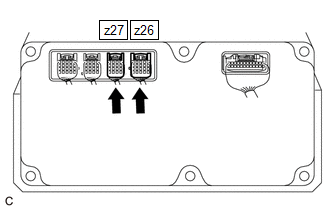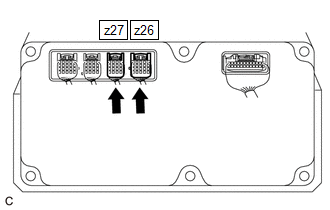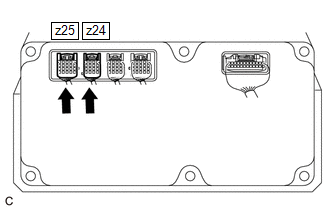- Hybrid/EV Battery Cell 1 to 56 Voltage
- Hybrid/EV Battery Cell 1 to 56 Internal Resistance
| Last Modified: 05-13-2024 | 6.11:8.1.0 | Doc ID: RM100000001N88S |
| Model Year Start: 2021 | Model: Corolla | Prod Date Range: [04/2020 - 09/2022] |
| Title: HYBRID / BATTERY CONTROL: HYBRID BATTERY SYSTEM (for LITHIUM-ION BATTERY with P610): P1AC413,P1AC513; Hybrid/EV Battery Stack 1 Current Interrupt Device Circuit Open; 2021 - 2022 MY Corolla Corolla HV [04/2020 - 09/2022] | ||
|
DTC |
P1AC413 |
Hybrid/EV Battery Stack 1 Current Interrupt Device Circuit Open |
|
DTC |
P1AC513 |
Hybrid/EV Battery Stack 2 Current Interrupt Device Circuit Open |
DESCRIPTION
The battery ECU assembly restricts charging and discharging of the HV battery and stores a DTC when a current interrupt device (CID) located in an HV battery cell has operated and the high voltage circuit is disconnected.
|
DTC No. |
Detection Item |
DTC Detection Condition |
Trouble Area |
MIL |
Warning Indicate |
|---|---|---|---|---|---|
|
P1AC413 |
Hybrid/EV Battery Stack 1 Current Interrupt Device Circuit Open |
A shut-off by a CID occurs. (1 trip detection logic) |
|
Comes on |
Master Warning Light: Comes on |
|
P1AC513 |
Hybrid/EV Battery Stack 2 Current Interrupt Device Circuit Open |
A shut-off by a CID occurs. (1 trip detection logic) |
|
Comes on |
Master Warning Light: Comes on |
Related Data List
|
DTC No. |
Data List |
|---|---|
|
P1AC413 |
|
|
P1AC513 |
MONITOR DESCRIPTION
If a current interrupt device (CID) located in a HV battery cell is shut off, the battery ECU assembly prohibits charging and discharging, illuminates the MIL and set a DTC.
MONITOR STRATEGY
|
Related DTCs |
P1AC4 (INF P1AC413): Hybrid/EV Battery Cell Voltage Low Pack Stack "A" at CID interception P1AC5 (INF P1AC513): Hybrid/EV Battery Cell Voltage Low Pack Stack "B" at CID interception |
|
Required sensors/components |
Battery ECU assembly |
|
Frequency of operation |
Continuous |
|
Duration |
TMC's intellectual property |
|
MIL operation |
1 driving cycle |
|
Sequence of operation |
None |
TYPICAL ENABLING CONDITIONS
|
The monitor will run whenever the following DTCs are not stored |
TMC's intellectual property |
|
Other conditions belong to TMC's intellectual property |
- |
TYPICAL MALFUNCTION THRESHOLDS
|
TMC's intellectual property |
- |
COMPONENT OPERATING RANGE
|
Battery ECU assembly |
DTC P1AC4 (INF P1AC413) is not detected DTC P1AC5 (INF P1AC513) is not detected |
CONFIRMATION DRIVING PATTERN
HINT:
- Connect the Techstream to the DLC3.
- Turn the power switch on (IG) and turn the Techstream on.
- Clear the DTCs (even if no DTCs are stored, perform the clear DTC procedure).
- Turn the power switch off and wait for 2 minutes or more.
- Turn the power switch on (IG) and wait for 10 seconds or more.[*1]
- Turn the power switch off and wait for 2 minutes or more.[*2]
- Turn the power switch on (READY) and turn the Techstream on.[*3]
-
With power switch on (READY) and wait for 30 seconds or more.[*4]
HINT:
[*1] to [*4]: Normal judgment procedure.
The normal judgment procedure is used to complete DTC judgment and also used when clearing permanent DTCs.
- Enter the following menus: Powertrain / HV Battery / Utility / All Readiness.
-
Check the DTC judgment result.
HINT:
- If the judgment result shows NORMAL, the system is normal.
- If the judgment result shows ABNORMAL, the system has a malfunction.
- If the judgment result shows INCOMPLETE or N/A, perform the normal judgment procedure again.
WIRING DIAGRAM
Refer to the wiring diagram for DTC P1A001C.
CAUTION / NOTICE / HINT
CAUTION:
-
Before the following operations are conducted, take precautions to prevent electric shock by turning the power switch off, wearing insulated gloves, and removing the service plug grip from HV battery.
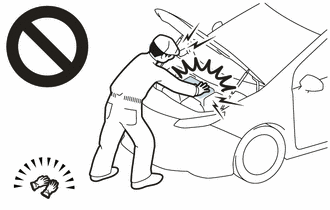
- Inspecting the high-voltage system
- Disconnecting the low voltage connector of the inverter with converter assembly
- Disconnecting the low voltage connector of the HV battery
-
To prevent electric shock, make sure to remove the service plug grip to cut off the high voltage circuit before servicing the vehicle.
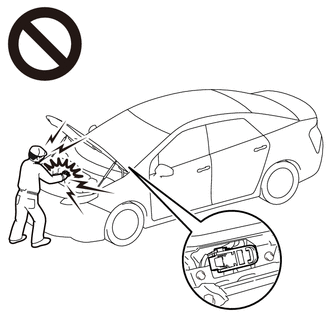
-
After removing the service plug grip from the HV battery, put it in your pocket to prevent other technicians from accidentally reconnecting it while you are working on the high-voltage system.
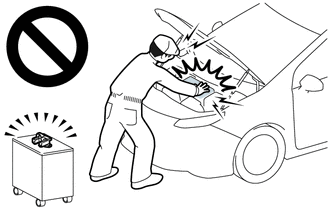
-
After removing the service plug grip, wait for at least 10 minutes before touching any of the high-voltage connectors or terminals. After waiting for 10 minutes, check the voltage at the terminals in the inspection point in the inverter with converter assembly. The voltage should be 0 V before beginning work.
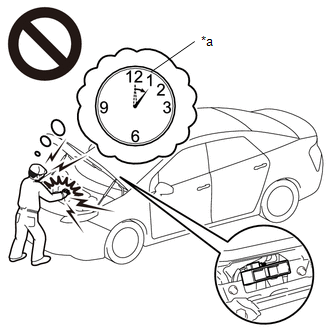
*a
Without waiting for 10 minutes
HINT:
Waiting for at least 10 minutes is required to discharge the high-voltage capacitor inside the inverter with converter assembly.
-
Make sure to insulate the high-voltage connectors and terminals of the HV battery with insulating tape after removing it.
If the HV battery stored without insulating the connectors and terminals, electric shock or fire may result.
-
When disposing of an HV battery, make sure to return it through an authorized collection agent who is capable of handling it safely. If the HV battery is returned via the manufacturer specified route, it will be returned properly and in a safe manner by an authorized collection agent.
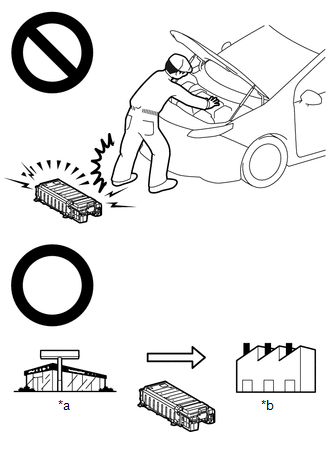
*a
Dealer
*b
Battery Collection Agent
- Accidents such as electric shock may result if the HV battery is disposed of improperly or abandoned. Therefore, make sure to return all HV batteries through an authorized collection agent.
- Before returning the HV battery, make sure to perform a recovery inspection.
- Before returning the HV supply stack sub-assembly, make sure to perform a recovery inspection.
- Make a note of the output DTCs as some of them may be necessary for recovery inspection of the HV battery and HV supply stack sub-assemblies.
-
After removing the HV battery, keep it away from water. Exposure to water may cause the HV battery to produce heat, resulting in a fire.
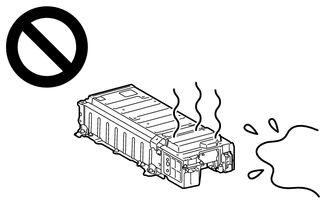
NOTICE:
- After turning the power switch off, waiting time may be required before disconnecting the cable from the negative (-) auxiliary battery terminal. Therefore, make sure to read the disconnecting the cable from the negative (-) auxiliary battery terminal notices before proceeding with work.
- Do not turn the power switch on (READY) until the repair is completed.
PROCEDURE
|
1. |
CHECK DTC OUTPUT (HV BATTERY, HYBRID CONTROL) |
(a) Connect the Techstream to the DLC3.
(b) Turn the power switch on (IG).
(c) Enter the following menus: Powertrain / HV Battery and Hybrid Control / Trouble Codes.
(d) Check for DTCs.
Powertrain > HV Battery > Trouble Codes
Powertrain > Hybrid Control > Trouble Codes
|
Result |
Proceed to |
|---|---|
|
"P1AC413 or P1AC513" only is output, or DTCs except the ones in the table below are also output. |
A |
|
DTCs of hybrid battery system in the table below are output. |
B |
|
DTCs of hybrid control system in the table below are output. |
C |
|
System |
Relevant DTC |
|
|---|---|---|
|
Hybrid Battery System |
P060A47 |
Hybrid/EV Battery Energy Control Module Monitoring Processor Watchdog / Safety MCU Failure |
|
P060B49 |
Hybrid/EV Battery Energy Control Module A/D Processing Internal Electronic Failure |
|
|
P060687 |
Hybrid/EV Battery Energy Control Module Processor to Monitoring Processor Missing Message |
|
|
Hybrid Control System |
P0A1F94 |
Hybrid/EV Battery Energy Control Module Unexpected Operation |
(e) Turn the power switch off.
| B |

|
| C |

|
|
|
2. |
CHECK DTC |
(a) Check the DTCs that were output when the vehicle was brought to the workshop.
|
Result |
Proceed to |
|---|---|
|
"P1AC413" is also output. |
A |
|
"P1AC513" is also output. |
B |
| B |

|
|
|
3. |
READ VALUE USING TECHSTREAM (HYBRID/EV BATTERY CELL 1 TO 28 VOLTAGE) |
(a) Connect the Techstream to the DLC3.
(b) Turn the power switch on (IG).
NOTICE:
Do not turn the power switch on (READY).
(c) Enter the following menus: Powertrain / HV Battery / Data List / Hybrid/EV Battery Cell 1 to 28 Voltage.
(d) Read the value of data list items "Hybrid/EV Battery cell 1 voltage" through "Hybrid/EV Battery cell 28 voltage" and make a note if the value of any is 1.6 V or less.
Powertrain > HV Battery > Data List
|
Tester Display |
|---|
|
Hybrid/EV Battery Cell 1 Voltage |
|
Hybrid/EV Battery Cell 2 Voltage |
|
Hybrid/EV Battery Cell 3 Voltage |
|
Hybrid/EV Battery Cell 4 Voltage |
|
Hybrid/EV Battery Cell 5 Voltage |
|
Hybrid/EV Battery Cell 6 Voltage |
|
Hybrid/EV Battery Cell 7 Voltage |
|
Hybrid/EV Battery Cell 8 Voltage |
|
Hybrid/EV Battery Cell 9 Voltage |
|
Hybrid/EV Battery Cell 10 Voltage |
|
Hybrid/EV Battery Cell 11 Voltage |
|
Hybrid/EV Battery Cell 12 Voltage |
|
Hybrid/EV Battery Cell 13 Voltage |
|
Hybrid/EV Battery Cell 14 Voltage |
|
Hybrid/EV Battery Cell 15 Voltage |
|
Hybrid/EV Battery Cell 16 Voltage |
|
Hybrid/EV Battery Cell 17 Voltage |
|
Hybrid/EV Battery Cell 18 Voltage |
|
Hybrid/EV Battery Cell 19 Voltage |
|
Hybrid/EV Battery Cell 20 Voltage |
|
Hybrid/EV Battery Cell 21 Voltage |
|
Hybrid/EV Battery Cell 22 Voltage |
|
Hybrid/EV Battery Cell 23 Voltage |
|
Hybrid/EV Battery Cell 24 Voltage |
|
Hybrid/EV Battery Cell 25 Voltage |
|
Hybrid/EV Battery Cell 26 Voltage |
|
Hybrid/EV Battery Cell 27 Voltage |
|
Hybrid/EV Battery Cell 28 Voltage |
(e) Turn the power switch off.
|
|
4. |
CHECK CONNECTOR CONNECTION CONDITION (BATTERY ECU ASSEMBLY CONNECTOR) |
CAUTION:
Be sure to wear insulated gloves and protective goggles.
(a) Check that the service plug grip is not installed.
NOTICE:
After removing the service plug grip, do not turn the power switch on (READY), unless instructed by the repair manual because this may cause a malfunction.
(b) Remove the No. 1 HV battery protector.
|
(c) Check the connector connections and contact pressure of the relevant terminals for the battery ECU assembly. OK: The connectors are connected securely and there are no contact problems. Result:
|
|
|||||||||||||
(d) Install the No. 1 HV battery protector.
| B |

|
CONNECT SECURELY |
| C |

|
|
|
5. |
CHECK NO. 1 HV SUPPLY STACK SUB-ASSEMBLY (HYBRID BATTERY CELL 1 to 28 VOLTAGE) |
CAUTION:
- Be sure to wear insulated gloves and protective goggles.
- Disconnect only the connector corresponding to the HV battery cell to be checked. Do not disconnect the other connectors.
NOTICE:
Make sure to use tester probes with a diameter of approximately 0.5 mm (0.0197 in.) when measuring the voltage of each HV battery cell.
(a) Check that the service plug grip is not installed.
NOTICE:
After removing the service plug grip, do not turn the power switch on (READY), unless instructed by the repair manual because this may cause a malfunction.
(b) Remove the No. 1 HV battery protector.
|
(c) Disconnect the z26 and z27 battery ECU assembly connectors. |
|
(d) Measure the voltage according to the value(s) in the table below.
HINT:
Measure the voltage of the HV battery cells whose value in the data list was 1.6 V or less only.

|
*a |
Rear view of wire harness connector (to Battery ECU Assembly) |
- |
- |
|
Hybrid Battery Cell |
Tester Connection |
Condition |
|---|---|---|
|
1 |
z26-16 (GA0) - z26-11 (VA1) |
Always |
|
2 |
z26-11 (VA1) - z26-6 (VA2) |
Always |
|
3 |
z26-6 (VA2) - z26-1 (VA3) |
Always |
|
4 |
z26-1 (VA3) - z26-17 (VA4) |
Always |
|
5 |
z26-17 (VA4) - z26-12 (VA5) |
Always |
|
6 |
z26-12 (VA5) - z26-7 (VA6) |
Always |
|
7 |
z26-7 (VA6) - z26-2 (VA7) |
Always |
|
8 |
z26-2 (VA7) - z26-18 (VA8) |
Always |
|
9 |
z26-18 (VA8) - z26-13 (VA9) |
Always |
|
10 |
z26-13 (VA9) - z26-8 (VA10) |
Always |
|
11 |
z26-8 (VA10) - z26-3 (VA11) |
Always |
|
12 |
z26-3 (VA11) - z26-19 (VA12) |
Always |
|
13 |
z26-19 (VA12) - z26-14 (VA13) |
Always |
|
14 |
z26-14 (VA13) - z26-9 (VA14) |
Always |
|
15 |
z26-9 (VA14) - z26-4 (VA15) |
Always |
|
16 |
z26-4 (VA15) - z26-20 (VA16) |
Always |
|
17 |
z26-20 (VA16) - z26-15 (VA17) |
Always |
|
18 |
z26-15 (VA17) - z26-10 (VA18) |
Always |
|
19 |
z26-10 (VA18) - z26-5 (VA19) |
Always |
|
20 |
z27-13 (GA1) - z27-9 (VA20) |
Always |
|
21 |
z27-9 (VA20) - z27-5 (VA21) |
Always |
|
22 |
z27-5 (VA21) - z27-14 (VA22) |
Always |
|
23 |
z27-14 (VA22) - z27-10 (VA23) |
Always |
|
24 |
z27-10 (VA23) - z27-15 (VA24) |
Always |
|
25 |
z27-15 (VA24) - z27-11 (VA25) |
Always |
|
26 |
z27-11 (VA25) - z27-16 (VA26) |
Always |
|
27 |
z27-16 (VA26) - z27-12 (VA27) |
Always |
|
28 |
z27-12 (VA27) - z27-8 (VA28) |
Always |
CAUTION:
Make sure not to cross the electrodes of an electrical tester measurement terminals.
NOTICE:
Make sure to check the polarity of each terminal (positive (+) or negative (-)) before connecting a tester.
|
Result |
Proceed to |
|---|---|
|
The voltage between the terminals is 1.6 V or less. |
A |
|
Other than above |
B |
(e) Reconnect the z26 and z27 battery ECU assembly connectors.
(f) Install the No. 1 HV battery protector.
| B |

|
|
|
6. |
CHECK BATTERY ECU ASSEMBLY (GA0 - VA28) |
NOTICE:
Make sure to use tester probes with a diameter of approximately 0.5 mm (0.0197 in.) when measuring the voltage.
(a) Remove the battery ECU assembly.
(b) Measure the voltage according to the value(s) in the table below.
HINT:
Only inspect the terminals of the battery ECU assembly which correspond to the HV battery cells which measured 1.6 V or less in the previous step.
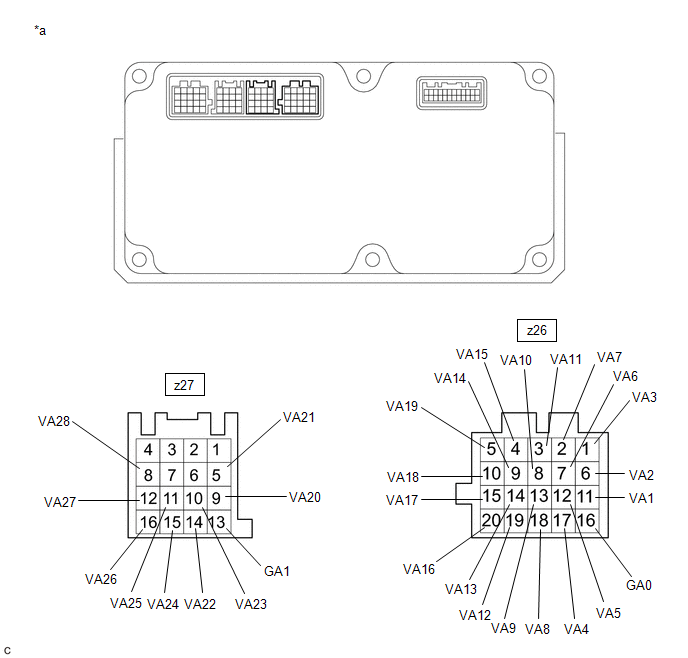
|
*a |
Component without harness connected (Battery ECU Assembly) |
- |
- |
Standard Voltage:
|
Hybrid Battery Cell |
Tester Connection (Tester Probe Polarity) |
Condition |
Specified Condition |
|---|---|---|---|
|
1 |
z26-16 (GA0) (-) - z26-11 (VA1) (+) |
Always |
0.3 to 1.0 V |
|
2 |
z26-11 (VA1) (-) - z26-6 (VA2) (+) |
Always |
0.3 to 1.0 V |
|
3 |
z26-6 (VA2) (-) - z26-1 (VA3) (+) |
Always |
0.3 to 1.0 V |
|
4 |
z26-1 (VA3) (-) - z26-17 (VA4) (+) |
Always |
0.3 to 1.0 V |
|
5 |
z26-17 (VA4) (-) - z26-12 (VA5) (+) |
Always |
0.3 to 1.0 V |
|
6 |
z26-12 (VA5) (-) - z26-7 (VA6) (+) |
Always |
0.3 to 1.0 V |
|
7 |
z26-7 (VA6) (-) - z26-2 (VA7) (+) |
Always |
0.3 to 1.0 V |
|
8 |
z26-2 (VA7) (-) - z26-18 (VA8) (+) |
Always |
0.3 to 1.0 V |
|
9 |
z26-18 (VA8) (-) - z26-13 (VA9) (+) |
Always |
0.3 to 1.0 V |
|
10 |
z26-13 (VA9) (-) - z26-8 (VA10) (+) |
Always |
0.3 to 1.0 V |
|
11 |
z26-8 (VA10) (-) - z26-3 (VA11) (+) |
Always |
0.3 to 1.0 V |
|
12 |
z26-3 (VA11) (-) - z26-19 (VA12) (+) |
Always |
0.3 to 1.0 V |
|
13 |
z26-19 (VA12) (-) - z26-14 (VA13) (+) |
Always |
0.3 to 1.0 V |
|
14 |
z26-14 (VA13) (-) - z26-9 (VA14) (+) |
Always |
0.3 to 1.0 V |
|
15 |
z26-9 (VA14) (-) - z26-4 (VA15) (+) |
Always |
0.3 to 1.0 V |
|
16 |
z26-4 (VA15) (-) - z26-20 (VA16) (+) |
Always |
0.3 to 1.0 V |
|
17 |
z26-20 (VA16) (-) - z26-15 (VA17) (+) |
Always |
0.3 to 1.0 V |
|
18 |
z26-15 (VA17) (-) - z26-10 (VA18) (+) |
Always |
0.3 to 1.0 V |
|
19 |
z26-10 (VA18) (-) - z26-5 (VA19) (+) |
Always |
0.3 to 1.0 V |
|
20 |
z27-13 (GA1) (-) - z27-9 (VA20) (+) |
Always |
0.3 to 1.0 V |
|
21 |
z27-9 (VA20) (-) - z27-5 (VA21) (+) |
Always |
0.3 to 1.0 V |
|
22 |
z27-5 (VA21) (-) - z27-14 (VA22) (+) |
Always |
0.3 to 1.0 V |
|
23 |
z27-14 (VA22) (-) - z27-10 (VA23) (+) |
Always |
0.3 to 1.0 V |
|
24 |
z27-10 (VA23) (-) - z27-15 (VA24) (+) |
Always |
0.3 to 1.0 V |
|
25 |
z27-15 (VA24) (-) - z27-11 (VA25) (+) |
Always |
0.3 to 1.0 V |
|
26 |
z27-11 (VA25) (-) - z27-16 (VA26) (+) |
Always |
0.3 to 1.0 V |
|
27 |
z27-16 (VA26) (-) - z27-12 (VA27) (+) |
Always |
0.3 to 1.0 V |
|
28 |
z27-12 (VA27) (-) - z27-8 (VA28) (+) |
Always |
0.3 to 1.0 V |
NOTICE:
- Make sure to check the polarity of each terminal (positive (+) or negative (-)) before connecting a tester.
- Be sure to set the toyota electrical tester to diode range when performing this test.
- Read the voltage after the value has stabilized.
- In order to avoid damaging the terminals of the battery ECU assembly, make sure to use tester probes with a diameter of approximately 0.5 mm (0.0197 in.) when measuring the voltage of the battery ECU assembly.
(c) Install the battery ECU assembly.
|
Result |
Proceed to |
|---|---|
|
The voltage between the terminals is 0.3 to 1.0 V. |
A |
|
Other than above |
B |
| A |

|
|
|
7. |
REPLACE NO. 1 HV SUPPLY STACK SUB-ASSEMBLY |
| NEXT |

|
|
8. |
READ VALUE USING TECHSTREAM (HYBRID/EV BATTERY CELL 29 TO 56 VOLTAGE) |
(a) Connect the Techstream to the DLC3.
(b) Turn the power switch on (IG).
NOTICE:
Do not turn the power switch on (READY).
(c) Enter the following menus: Powertrain / HV Battery / Data List / Hybrid/EV Battery Cell 29 to 56 Voltage.
(d) Read the value of data list items "Hybrid/EV Battery cell 29 voltage" through "Hybrid/EV Battery cell 56 voltage" and make a note if the value of any is 1.6 V or less.
Powertrain > HV Battery > Data List
|
Tester Display |
|---|
|
Hybrid/EV Battery Cell 29 Voltage |
|
Hybrid/EV Battery Cell 30 Voltage |
|
Hybrid/EV Battery Cell 31 Voltage |
|
Hybrid/EV Battery Cell 32 Voltage |
|
Hybrid/EV Battery Cell 33 Voltage |
|
Hybrid/EV Battery Cell 34 Voltage |
|
Hybrid/EV Battery Cell 35 Voltage |
|
Hybrid/EV Battery Cell 36 Voltage |
|
Hybrid/EV Battery Cell 37 Voltage |
|
Hybrid/EV Battery Cell 38 Voltage |
|
Hybrid/EV Battery Cell 39 Voltage |
|
Hybrid/EV Battery Cell 40 Voltage |
|
Hybrid/EV Battery Cell 41 Voltage |
|
Hybrid/EV Battery Cell 42 Voltage |
|
Hybrid/EV Battery Cell 43 Voltage |
|
Hybrid/EV Battery Cell 44 Voltage |
|
Hybrid/EV Battery Cell 45 Voltage |
|
Hybrid/EV Battery Cell 46 Voltage |
|
Hybrid/EV Battery Cell 47 Voltage |
|
Hybrid/EV Battery Cell 48 Voltage |
|
Hybrid/EV Battery Cell 49 Voltage |
|
Hybrid/EV Battery Cell 50 Voltage |
|
Hybrid/EV Battery Cell 51 Voltage |
|
Hybrid/EV Battery Cell 52 Voltage |
|
Hybrid/EV Battery Cell 53 Voltage |
|
Hybrid/EV Battery Cell 54 Voltage |
|
Hybrid/EV Battery Cell 55 Voltage |
|
Hybrid/EV Battery Cell 56 Voltage |
(e) Turn the power switch off.
|
|
9. |
CHECK CONNECTOR CONNECTION CONDITION (BATTERY ECU ASSEMBLY CONNECTOR) |
CAUTION:
Be sure to wear insulated gloves and protective goggles.
(a) Check that the service plug grip is not installed.
NOTICE:
After removing the service plug grip, do not turn the power switch on (READY), unless instructed by the repair manual because this may cause a malfunction.
(b) Remove the No. 1 HV battery protector.
|
(c) Check the connector connections and contact pressure of the relevant terminals for the battery ECU assembly. OK: The connectors are connected securely and there are no contact problems. |
|
(d) Install the No. 1 HV battery protector.
|
Result |
Proceed to |
|
|---|---|---|
|
OK |
A |
|
|
Not connected securely |
The terminals are not damaged or corroded |
B |
|
Not connected securely |
The terminals are damaged or corroded |
C |
| B |

|
CONNECT SECURELY |
| C |

|
|
|
10. |
CHECK NO. 2 HV SUPPLY STACK SUB-ASSEMBLY (HYBRID BATTERY CELL 29 TO 56 VOLTAGE) |
CAUTION:
- Be sure to wear insulated gloves and protective goggles.
- Disconnect only the connector corresponding to the HV battery cell to be checked. Do not disconnect the other connectors.
NOTICE:
Make sure to use tester probes with a diameter of approximately 0.5 mm (0.0197 in.) when measuring the voltage of each HV battery cell.
(a) Check that the service plug grip is not installed.
NOTICE:
After removing the service plug grip, do not turn the power switch on (READY), unless instructed by the repair manual because this may cause a malfunction.
(b) Remove the No. 1 HV battery protector.
|
(c) Disconnect the z24 and z25 battery ECU assembly connectors. |
|
(d) Measure the voltage according to the value(s) in the table below.
HINT:
Measure the voltage of the HV battery cells whose value in the data list was 1.6 V or less only.

|
*a |
Rear view of wire harness connector (to Battery ECU Assembly) |
- |
- |
|
Hybrid Battery Cell |
Tester Connection |
Condition |
|---|---|---|
|
29 |
z24-5 (VAD) - z24-9 (VA29) |
Always |
|
30 |
z24-9 (VA29) - z24-13 (VA30) |
Always |
|
31 |
z24-13 (VA30) - z24-10 (VA31) |
Always |
|
32 |
z24-10 (VA31) - z24-14 (VA32) |
Always |
|
33 |
z24-14 (VA32) - z24-11 (VA33) |
Always |
|
34 |
z24-11 (VA33) - z24-15 (VA34) |
Always |
|
35 |
z24-15 (VA34) - z24-8 (VA35) |
Always |
|
36 |
z24-8 (VA35) - z24-12 (VA36) |
Always |
|
37 |
z24-12 (VA36) - z24-16 (VA37) |
Always |
|
38 |
z25-1 (GA2) - z25-6 (VA38) |
Always |
|
39 |
z25-6 (VA38) - z25-11 (VA39) |
Always |
|
40 |
z25-11 (VA39) - z25-16 (VA40) |
Always |
|
41 |
z25-16 (VA40) - z25-2 (VA41) |
Always |
|
42 |
z25-2 (VA41) - z25-7 (VA42) |
Always |
|
43 |
z25-7 (VA42) - z25-12 (VA43) |
Always |
|
44 |
z25-12 (VA43) - z25-17 (VA44) |
Always |
|
45 |
z25-17 (VA44) - z25-3 (VA45) |
Always |
|
46 |
z25-3 (VA45) - z25-8 (VA46) |
Always |
|
47 |
z25-8 (VA46) - z25-13 (VA47) |
Always |
|
48 |
z25-13 (VA47) - z25-18 (VA48) |
Always |
|
49 |
z25-18 (VA48) - z25-4 (VA49) |
Always |
|
50 |
z25-4 (VA49) - z25-9 (VA50) |
Always |
|
51 |
z25-9 (VA50) - z25-14 (VA51) |
Always |
|
52 |
z25-14 (VA51) - z25-19 (VA52) |
Always |
|
53 |
z25-19 (VA52) - z25-5 (VA53) |
Always |
|
54 |
z25-5 (VA53) - z25-10 (VA54) |
Always |
|
55 |
z25-10 (VA54) - z25-15 (VA55) |
Always |
|
56 |
z25-15 (VA55) - z25-20 (VA56) |
Always |
CAUTION:
Make sure not to cross the electrodes of an electrical tester measurement terminals.
NOTICE:
Make sure to check the polarity of each terminal (positive (+) or negative (-)) before connecting a tester.
|
Result |
Proceed to |
|---|---|
|
The voltage between the terminals is 1.6 V or less. |
A |
|
Other than above |
B |
(e) Reconnect the z24 and z25 battery ECU assembly connectors.
(f) Install the No. 1 HV battery protector.
| B |

|
|
|
11. |
CHECK BATTERY ECU ASSEMBLY (VAD - VA56) |
NOTICE:
Make sure to use tester probes with a diameter of approximately 0.5 mm (0.0197 in.) when measuring the voltage.
(a) Remove the battery ECU assembly.
(b) Measure the voltage according to the value(s) in the table below.
HINT:
Only inspect the terminals of the battery ECU assembly which correspond to the HV battery cells which measured 1.6 V or less in the previous step.
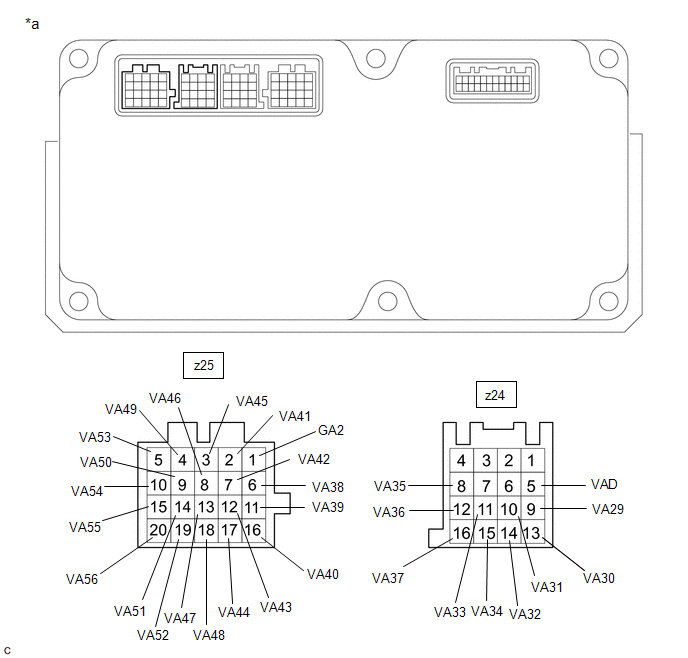
|
*a |
Component without harness connected (Battery ECU Assembly) |
- |
- |
Standard Voltage:
|
Hybrid Battery Cell |
Tester Connection (Tester Probe Polarity) |
Condition |
Specified Condition |
|---|---|---|---|
|
29 |
z24-5 (VAD) (-) - z24-9 (VA29) (+) |
Always |
0.3 to 1.0 V |
|
30 |
z24-9 (VA29) (-) - z24-13 (VA30) (+) |
Always |
0.3 to 1.0 V |
|
31 |
z24-13 (VA30) (-) - z24-10 (VA31) (+) |
Always |
0.3 to 1.0 V |
|
32 |
z24-10 (VA31) (-) - z24-14 (VA32) (+) |
Always |
0.3 to 1.0 V |
|
33 |
z24-14 (VA32) (-) - z24-11 (VA33) (+) |
Always |
0.3 to 1.0 V |
|
34 |
z24-11 (VA33) (-) - z24-15 (VA34) (+) |
Always |
0.3 to 1.0 V |
|
35 |
z24-15 (VA34) (-) - z24-8 (VA35) (+) |
Always |
0.3 to 1.0 V |
|
36 |
z24-8 (VA35) (-) - z24-12 (VA36) (+) |
Always |
0.3 to 1.0 V |
|
37 |
z24-12 (VA36) (-) - z24-16 (VA37) (+) |
Always |
0.3 to 1.0 V |
|
38 |
z25-1 (GA2) (-) - z25-6 (VA38) (+) |
Always |
0.3 to 1.0 V |
|
39 |
z25-6 (VA38) (-) - z25-11 (VA39) (+) |
Always |
0.3 to 1.0 V |
|
40 |
z25-11 (VA39) (-) - z25-16 (VA40) (+) |
Always |
0.3 to 1.0 V |
|
41 |
z25-16 (VA40) (-) - z25-2 (VA41) (+) |
Always |
0.3 to 1.0 V |
|
42 |
z25-2 (VA41) (-) - z25-7 (VA42) (+) |
Always |
0.3 to 1.0 V |
|
43 |
z25-7 (VA42) (-) - z25-12 (VA43) (+) |
Always |
0.3 to 1.0 V |
|
44 |
z25-12 (VA43) (-) - z25-17 (VA44) (+) |
Always |
0.3 to 1.0 V |
|
45 |
z25-17 (VA44) (-) - z25-3 (VA45) (+) |
Always |
0.3 to 1.0 V |
|
46 |
z25-3 (VA45) (-) - z25-8 (VA46) (+) |
Always |
0.3 to 1.0 V |
|
47 |
z25-8 (VA46) (-) - z25-13 (VA47) (+) |
Always |
0.3 to 1.0 V |
|
48 |
z25-13 (VA47) (-) - z25-18 (VA48) (+) |
Always |
0.3 to 1.0 V |
|
49 |
z25-18 (VA48) (-) - z25-4 (VA49) (+) |
Always |
0.3 to 1.0 V |
|
50 |
z25-4 (VA49) (-) - z25-9 (VA50) (+) |
Always |
0.3 to 1.0 V |
|
51 |
z25-9 (VA50) (-) - z25-14 (VA51) (+) |
Always |
0.3 to 1.0 V |
|
52 |
z25-14 (VA51) (-) - z25-19 (VA52) (+) |
Always |
0.3 to 1.0 V |
|
53 |
z25-19 (VA52) (-) - z25-5 (VA53) (+) |
Always |
0.3 to 1.0 V |
|
54 |
z25-5 (VA53) (-) - z25-10 (VA54) (+) |
Always |
0.3 to 1.0 V |
|
55 |
z25-10 (VA54) (-) - z25-15 (VA55) (+) |
Always |
0.3 to 1.0 V |
|
56 |
z25-15 (VA55) (-) - z25-20 (VA56) (+) |
Always |
0.3 to 1.0 V |
NOTICE:
- Make sure to check the polarity of each terminal (positive (+) or negative (-)) before connecting a tester.
- Be sure to set the toyota electrical tester to diode range when performing this test.
- Read the voltage after the value has stabilized.
- In order to avoid damaging the terminals of the battery ECU assembly, make sure to use tester probes with a diameter of approximately 0.5 mm (0.0197 in.) when measuring the voltage of the battery ECU assembly.
(c) Install the battery ECU assembly.
|
Result |
Proceed to |
|---|---|
|
The voltage between the terminals is 0.3 to 1.0 V. |
A |
|
Other than above |
B |
| A |

|
|
|
12. |
REPLACE NO. 2 HV SUPPLY STACK SUB-ASSEMBLY |
| NEXT |

|
|
|
|
![2021 - 2022 MY Corolla Corolla HV [04/2020 - 09/2022]; HYBRID / BATTERY CONTROL: HYBRID BATTERY SYSTEM (for LITHIUM-ION BATTERY with P610): UTILITY](/t3Portal/stylegraphics/info.gif)

